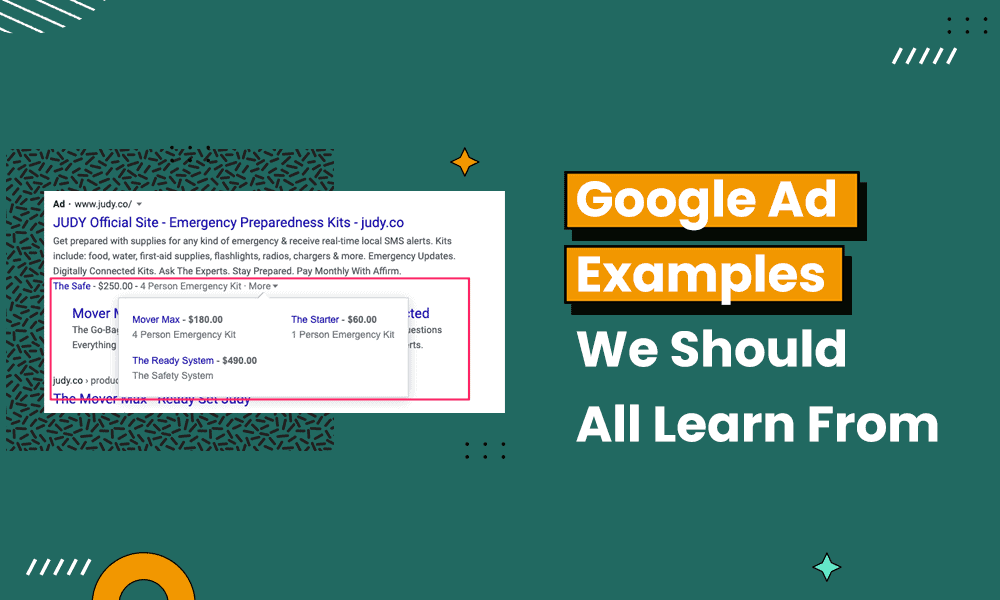Are you actively focusing on getting more website traffic or getting leads through your landing pages? Like everyone else, are you starting your journey with Search Engine Optimisation (SEO)? Are the results taking too long? If so, you need to learn a thing or two from the Google Ad examples we have here.
SEO is a great long-term goal for digital marketers. But that’s the thing–it’s long-term. It is a slow process, a long game. But if you want quick results, Google ads will strike the right nerve. As it is, 30% of Google’s top searches are ads. Organic results come later.
So, if you want to stand out among the over 8.5 billion Google searches in a day, this blog is for you.
Table of Contents
Why Should You Care About Running Google Ad Campaigns?
There are some clear benefits of incorporating Google Ad Campaigns into your digital marketing strategy. Let’s have a closer look.
- Immediate visibility: SEO efforts are essential but take time to bear fruit. In contrast, Google Ads offers instant visibility, propelling your business to the top of search results promptly when managed correctly.
- Precise targeting: With Google Ads, you can segment your audience and target your ads with precision, reaching potential customers by their search terms, geographic location, the type of device they’re using, and even the time of day they’re searching.
- Control over budget: Google Ads gives you control over how you spend your money. Whether it’s a modest amount or a larger investment, you can set your daily budget and adjust the spending as your campaign progresses.
- Valuable insights: Google Ads provides actionable insights through its analytics. This data is vital for understanding campaign performance and optimizing your ads for better results.
- Local business boost: Google Ads can be especially powerful for marketing local businesses. It can increase foot traffic by targeting ads to local customers and highlighting your presence in local search results.
- Adaptability: Google Ads campaigns are highly adaptable. You can test different ad variations, adjust your strategy based on performance, and respond quickly to market trends.
An Overview of Google Ads
Google Ads is a digital advertising platform where users pay-per-click (PPC). It facilitates some ad space, similar to billboards at the top of the Search Engine Results Page (SERP), as seen in the image below.

In Google ads’ PPC format, users pay for each click or impression on the ad. The platform is optimized to drive targeted and qualified traffic, generate leads, and boost in-store visits by placing your ads in the right place at the right time.
Your Google ads will appear on three primary platforms: Google Search, Google Maps, and YouTube.
This works by creating an ad, optimizing it with the keywords and intent you are running the ad for, and then having Google ads display it whenever somebody searches for similar terms.
Therefore, only the people looking for what you’re offering will see the ad. By reaching this target audience for you, Google ads help your business get the most authentic and qualified results from your campaign.
Terms Related to Google Ads You Should Know
The terminology and lingo can be confusing for someone starting their Google Ads journey. So, before we proceed to the nitty-gritty of it, let’s have a glance at some terms that you should be aware of.
Impressions
Impressions indicate the number of ‘eyeballs’ your ad gets. It is a measurement tool that defines the number of times the ad is displayed.
AdRank
AdRank determines where your ad is placed on the SERPs. The higher the AdRank value, the higher you’ll be placed and the more impressions and clicks you’ll get with your ad. The AdRank of a campaign is defined by the maximum bid multiplied by your Quality Score.
Bidding
The Google Ads platform runs on a bidding system, wherein you (the advertiser) will determine the maximum bid you’d like to pay per click. Since AdRank is directly tied to your bid, the higher you bid, the higher your ad will be placed on SERPs. You’ll find three bidding options on the platform:
- Cost per Click (CPC) is the amount you pay for each click on your ad.
- Cost per mile (CPM) is the amount you pay for one thousand ad impressions.
- Cost per engagement (CPE) is the amount you pay when someone takes a pre-defined desired action on your ad.
Display Network
Whenever a Google ad campaign appears on a website, the site is on the Google Display Network (GDN). GDN is a list of websites that allow and authorize the display of Google Ads campaigns on their platforms.
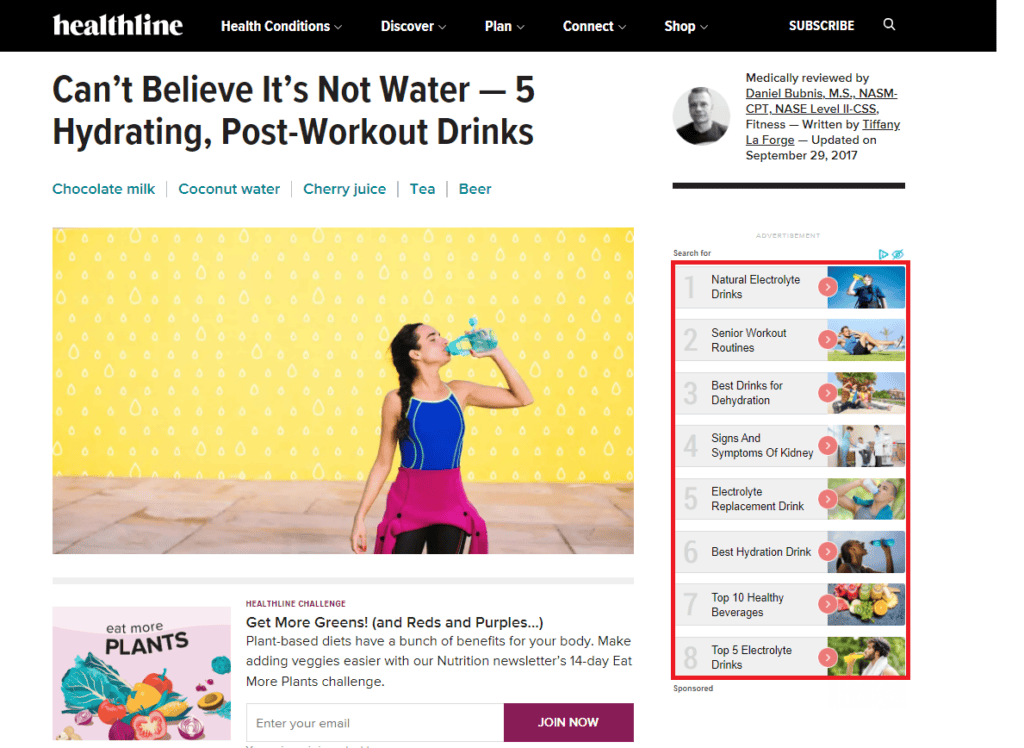
Campaign Type
Google Ads has nine types of campaigns, as follows.
- Search ads: These ads appear in Google search results when someone searches for predetermined keywords.
- Display ads: These are visual ads (like banners) that appear on websites within the Google Display Network.
- Video ads: These ads are played before, during, or after YouTube videos.
- Shopping ads: Google shopping ads showcase your product images, prices, and business name on the search page, like a digital storefront in Google’s shopping section.
- App ads: Aimed at promoting mobile apps, these ads appear across Search, Play Store, YouTube, and the Display Network, working like a recommendation to try an app.
- Smart ads: Designed for simplicity and time-saving, Smart Campaigns automatically optimize your ads based on the goals you set. They are more high converting and priced.
- Local ads: These are geared towards driving physical traffic to brick-and-mortar businesses by showing ads across Google’s platforms to people nearby.
- Performance Max ads: A type of campaign that uses Google’s AI to optimize ad placements across all Google platforms (Search, YouTube, Gmail, etc.) to achieve specific conversion goals.
- Discovery ads: These ads appear on Google’s ‘Discover’ feature, aiming to catch the interest of people browsing content related to your business.

Ad Extensions
Ad extensions are additional pieces of information that accompany your primary ad. They can be phone numbers, location details, links, or even event details. Any piece of information that will make your ad clearer.

Some Google Ad Examples for Inspiration
Let’s look at some Google Ad examples that will help you have a clearer view of what each type is like. You can also use these examples to draw inspiration for your ads.
Blacklane Airport Transport
This Blacklane ad is a great Google ad example because of its clarity and targeted appeal.
Key phrases like “arrive on time and in style” and “carbon-neutral rides” tap into the desires of environmentally conscious travelers who don’t want to sacrifice comfort. Therefore, the use of site link extensions, with direct calls to action such as “Book now for peace of mind,” effectively caters to users’ need for convenience and quick booking options.
The professional image of a chauffeur aligns with the upscale service being offered, ensuring the ad speaks directly to the intended affluent audience.
With concise language and strategic keywords, it’s crafted to convert searches into bookings efficiently.
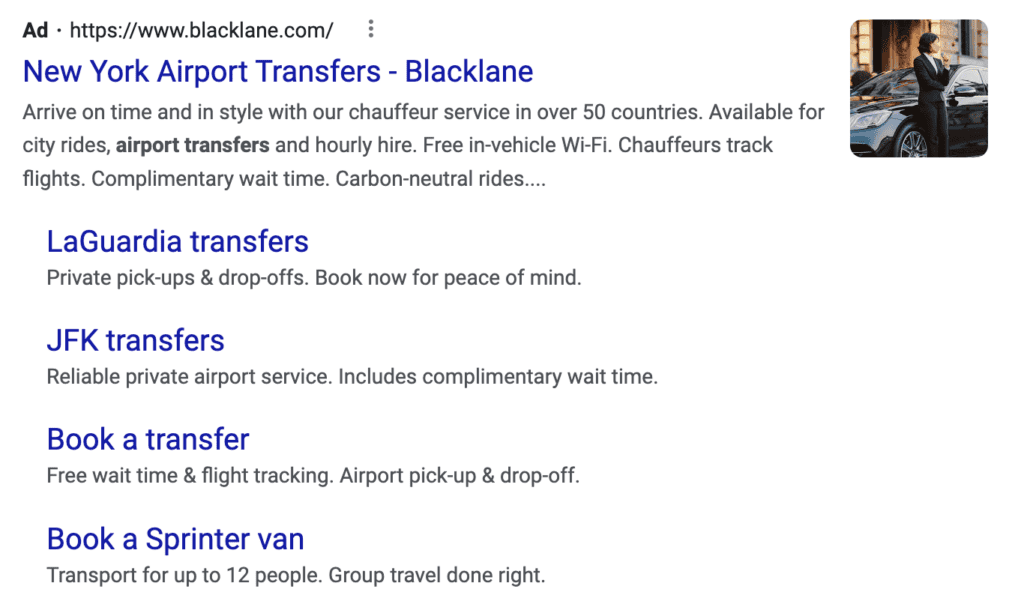
SEMrush steals back traffic from competition
In this example, SEMrush’s ad cleverly targets users searching for alternatives to its platform. Here, by including “Alternatives for SEMrush?” in the headline, they acknowledge the search intent while confidently suggesting that SEMrush outperforms competitors.
The ad lists impressive features and expansive database credentials, indirectly challenging users to compare and see SEMrush’s superior value.
The strategic use of the competitor’s keyword not only intercepts traffic but positions SEMrush as the premier choice, guiding users further down the conversion funnel with a strong, comparative edge.
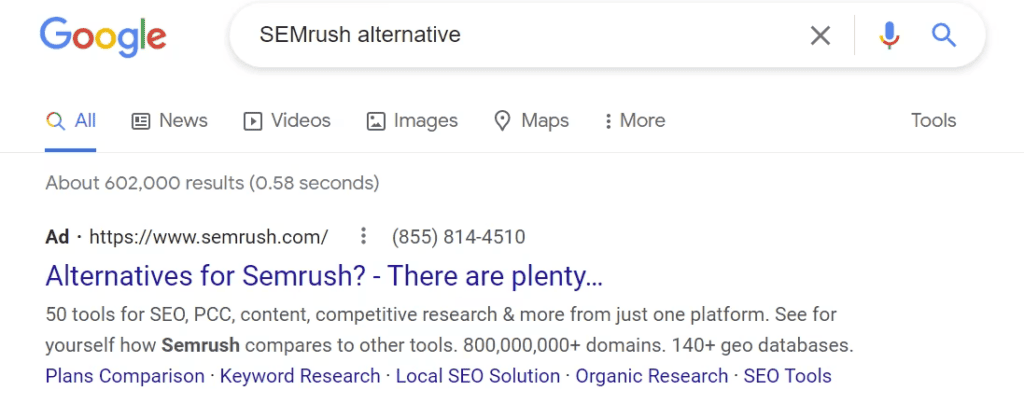
Thrice the persuasion by Boden
Boden’s Google Shopping ads stand out by effectively utilizing a trio of persuasive elements.
Firstly, showcasing discounts taps into the shopper’s desire for savings, acting as an immediate draw. The use of unique, high-quality imagery distinctively presents their products, aiding in capturing attention in a crowded marketplace.
Also, incorporating star ratings directly into the ads leverages social proof, bolstering buyer confidence and helping the products shine amongst competitors.
These strategies, combined with the smart use of the Performance Max campaigns, pinpoint customers at a crucial moment in their purchasing journey, making Boden’s ads not just visible but enormously compelling.
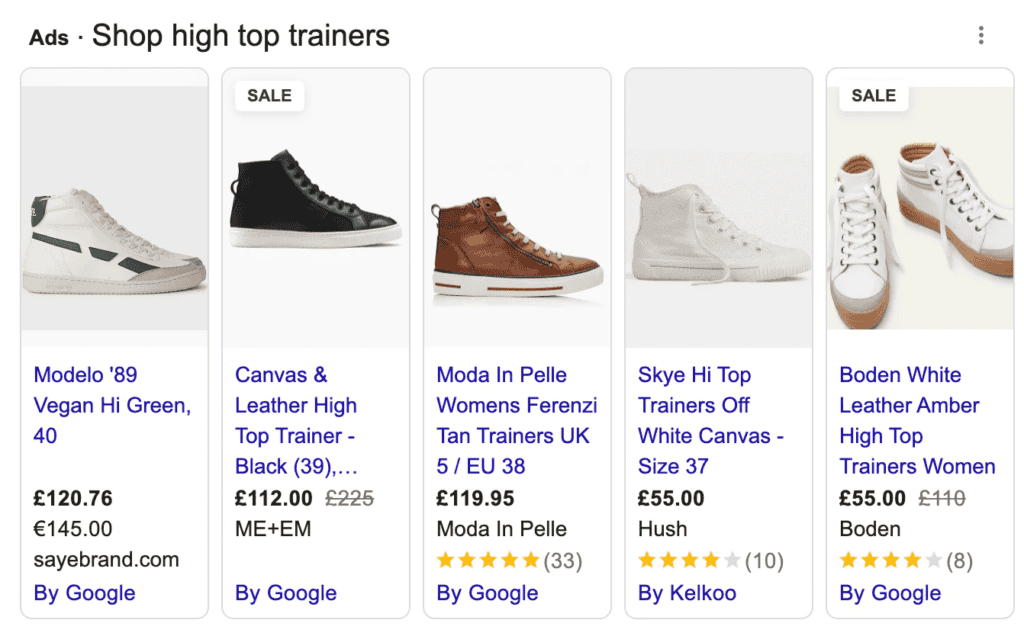
Never discount the power of discounts
Tails.com’s ad strategy immediately captures attention with a significant discount offer for first-time orders. They clearly understand that cost savings are a powerful motivator for new customers.
The ad prominently displays an impressive number of positive reviews, lending credibility and building trust through social proof. By emphasizing personalization in its ad—”Food Tailored To Your Dog,” it directly appeals to pet owners’ desire for customized solutions, enhancing click-through potential.
Tails.com presents not just a product but a tailored experience, promising to meet the unique needs of each dog. Thus, it creates a compelling reason for pet owners to choose its service over standard options.

Using visuals the right way
PlayerUnknown’s Battlegrounds (PUBG) showcases a daring approach to Google Ads that mirrors the intense energy of the game itself.
They immediately communicate the action and thrill of gameplay by repurposing imagery from the game’s cover for their display ads. This strategy may not follow the traditional clean-cut ad design, but it capitalizes on brand recognition and aligns perfectly with the product’s core experience.
This Display ad assertively reminds us that sometimes breaking the conventional rules can lead to a stronger connection with your audience, especially when it’s true to your brand’s identity.
PUBG’s ad demonstrates the value of testing innovative concepts against standard formats to stand out in a digital space where being bold can pay off.

Why Is Choosing the Right Type of Google Ads Campaign Crucial?
Before you start building your Google Ads campaign, you need to find the right campaign type you want to run. Here’s why.
- Alignment with business goals: Different campaigns serve different purposes. Whether you aim to drive sales, increase web traffic, or improve brand awareness, selecting the appropriate campaign type is key to achieving your business objectives.
- Resource optimization: Your budget and resources aren’t infinite. Therefore, choosing the right campaign helps you allocate your funds effectively, ensuring that every dollar spent is an investment.
- Audience relevance: The campaign type determines how and where your ads will be displayed. Matching the campaign to your target audience’s preferences and online behaviors will significantly increase the relevance and impact of your ads.
- Maximizing ROI: Each campaign type has its strengths. Therefore, by choosing the one that aligns best with your desired outcome, you will maximize the return on investment, getting more results for your spending.
- Ad content utilization: Certain types of campaigns are better suited for different ad content. For example, visually appealing products may perform better in a shopping campaign, whereas services might excel in search campaigns.
Read also: Native Advertising Examples That Master the Art of Subtle Selling
How To Craft Effective Google Ad Campaigns
Crafting an effective Google Ads Campaign is a long process with multiple steps to be taken care of. Let’s walk through all of them in detail.
Step 1: Relevant keywords selection
Keywords are a defining factor of your Google Ads campaign. They determine when your ads will appear in the search results. Here’s how to ensure you’re selecting the right keywords.
- Use keyword tools: Tools like Google’s Keyword Planner will help you find keywords related to your business that are frequently searched for but have manageable competition.
- Analyze search intent: Always understand the intent behind the searches. Are users looking to buy now, or are they seeking information? Your keywords and content should match these intentions.
- Consider long-tail keywords: These are longer, more specific queries that often have lower competition and higher conversion rates. Using them is effective because they more closely match user intent.
- Study competitors: See what keywords competitors are bidding on. This will give you insight into industry standards and reveal overlooked niche keywords.
- Focus on relevance: Choose keywords that are highly relevant to the ads you’ll be running. Irrelevant keywords lead to poor campaign performance and wasted spend.
- Organize by ad group: Group your keywords into themes. These groups will correspond to your different offerings, making your ads more targeted and relevant.
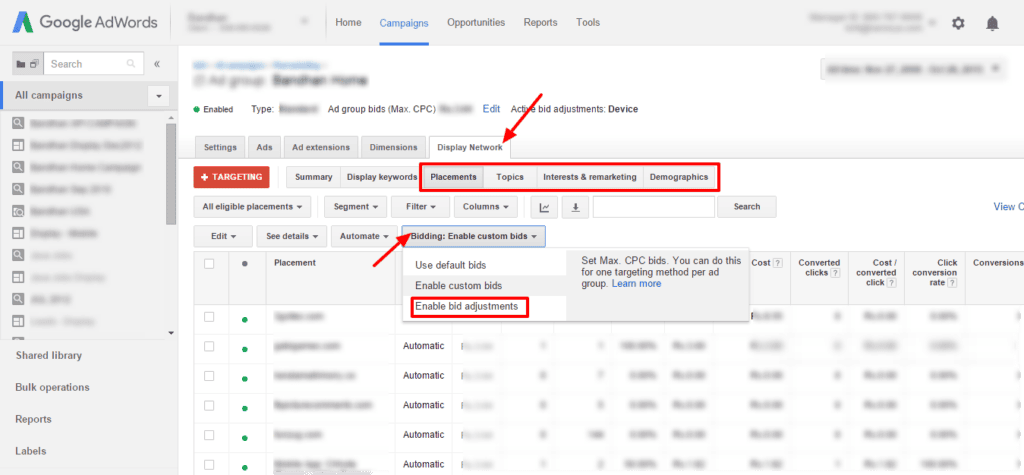
Step 2: Choosing ad format
Each format serves a distinct purpose. Consider your target customer’s journey and choose the format that aligns with the various touchpoints along that path. The right ad format for your business depends on your specific campaign goals and the nature of your offerings:
- Text ads: Ideal for service-based businesses and B2B companies focusing on search-driven leads. They fit well with intent-based campaigns where users are looking for specific solutions.
- Display ads: Suited for businesses with visually appealing products or those looking to build brand awareness. They are also great for retargeting campaigns that can visually remind users of products they’ve viewed.
- Shopping ads: A must for e-commerce retailers as they directly showcase products and facilitate easy comparison shopping, driving direct sales.
- Video ads: Beneficial for businesses aiming to demonstrate products or services in action, such as tech gadgets, or for creating a narrative around your brand.
- App ads: Perfect for mobile app developers or companies with app-based services looking to boost installations and user engagement.

Step 3: Writing the ad copy
The content of your ad is your direct communication with potential customers. Keep ad copy concise but impactful, considering the limited space. Use A/B testing to refine and identify what resonates best with your audience. Here’s how to make it count:
- Incorporate keywords: Integrate your researched keywords into the ad copy to ensure relevance to the user’s search query.
- Highlight the benefits: Clearly articulate what you offer and why it matters to the customer. Focus on benefits rather than just features–ROI sells faster.
- Use emotional triggers: Words that evoke emotion or a sense of urgency can drive users to take action. Include phrases like “limited-time offer” or “exclusive deal.”
- Clear call-to-action: Be direct about what you want the user to do next. Use strong action verbs like “Get,” “Start,” “Build,” or “Join.”
- Value proposition: Make your Unique Selling Proposition (USP) unmistakable. If you offer something unique, like free shipping or a money-back guarantee, make sure it’s front and center.
- Match ad to landing page: Ensure your ad copy is consistent with the messaging on your landing page. This coherence can improve your conversion rates.

Step 4: Creating visuals for the ad (for non-text ads)
For display, shopping, and video ads, visuals play a crucial role in attracting attention and conveying your message. Here’s how to ensure your ad visuals stand out:
- Consistency with branding: Your ad visuals should align with your brand identity. Use consistent colors, fonts, and style to reinforce brand recognition.
- Quality and clarity: Use high-resolution images and clear, legible text. For video ads, ensure high production value to maintain viewer engagement.
- Focus on the product/service: Make the product or service the star of your ad. For products, use images that showcase the item. For services, consider visuals that represent the benefits or outcomes of your service.
- Emotional appeal: Visuals that evoke an emotional response can significantly impact engagement and recall. Choose images or scenes that resonate emotionally with your target audience.
- Use of space: For display ads, effectively use the space to balance visuals and text without overcrowding. Ensure your message is easy to understand at a glance.
- Call-to-action: Include a visual CTA in your ad, such as a button with text, to make it clear what action you want the viewer to take.
Read also: What is Cost Per Action (CPA)? Benefits, Challenges, and Tips
Step 5: Setting up ad extensions
Ad extensions expand your advertisement, offering additional information and ways for users to interact with your ad, which can significantly improve its performance.
Use them strategically to provide as much relevant information as possible without overwhelming your audience. Remember, not all extensions will be displayed all the time, so prioritize the ones most important to your business and campaign goals.
- Sitelink extensions: Use these to link to specific pages on your site, such as product categories, contact forms, or special offers. This allows users to jump directly to what interests them, increasing the chances of conversion.
- Call extensions: If phone calls are valuable to your business, adding a phone number directly in the ad can drive calls. This is especially effective for mobile viewers.
- Location extensions: For businesses with physical locations, showing your address can help attract local customers and drive foot traffic.
- Callout extensions: Highlight special offers or features of your business, like free shipping, 24/7 customer service, or exclusive products.
- Structured snippet extensions: These provide a way to showcase a range of products or services your business offers. They help users grasp the breadth of what you offer at a glance.
- Image extensions: Adding an image to your text ad can increase its appeal and the space it occupies in search results, making it more noticeable.

Step 6: Managing the bidding strategy
Your bidding strategy is a crucial component that influences how your Google Ads are served. It determines how you pay for viewers to interact with your ads and how your ads compete in the auction. Here’s how to navigate your bidding strategy effectively:
- Understand your options: Google offers several bidding strategies, including cost-per-click (CPC), cost-per-thousand impressions (CPM), and cost-per-acquisition (CPA). Choose based on what action (clicks, impressions, conversions) you value most.
- Start with manual CPC: For new advertisers, starting with manual CPC gives you control over your bids for different keywords. Therefore, you can eventually learn which terms are most valuable.
- Consider automated bidding: Once you have enough data, automated bidding strategies like Target ROAS can optimize bids using machine learning to achieve your specified goals.
- Adjust bids for high-performance keywords: If certain keywords are driving conversions, consider increasing your bids on those terms to maximize visibility and results.
- Use bid adjustments: Google allows you to adjust bids for specific scenarios, such as targeting mobile devices or certain times of the day. Use these adjustments to optimize bids based on performance data.
- Monitor and refine: Your optimal bidding strategy will evolve. Regularly review performance data and adjust your strategy as needed to ensure you’re meeting your campaign objectives efficiently.
Read also: SEO for Dropshipping: Strategies to Drive Traffic and Revenue
How To Measure the Success of Your Google Ad?
Your Google Ad campaigns’ success can be gauged by a set of metrics and Key Performance Indicators (KPIs) that provide insights into how your ads are performing about your marketing objectives.
- Click-through rate (CTR): A fundamental metric, CTR indicates the ratio of users who click on your ad to the number of total users who viewed the ad (impressions). CTR directly affects your Quality Score and indicates how relevant and engaging your ad is.
- Conversion rate: Going beyond clicks, conversion rate looks at how many clicks result in a predefined action, like a sale or a newsletter subscription. It is a direct measure of your ad’s effectiveness in encouraging users to complete a goal action.
- Quality score: Quality Score is Google’s rating of the quality and relevance of both your keywords and PPC ads. It is based on your CTR, the relevance of each keyword to its ad group, landing page quality, and relevance, as well as your historical Google Ads account performance.
- Cost per click (CPC): This metric helps you evaluate the financial efficiency of your ads. By comparing CPC to conversion rate, you can determine whether the cost of clicks is proportional to the value those clicks bring.
- Impression share: Impression Share reflects the percentage of times your ads appeared out of the total number of times they could have appeared, based on your current keywords and settings. A low impression share suggests you might need to increase your bids or improve your ad quality to compete more effectively.
- Return on Ad Spend (ROAS): Calculated by dividing the revenue generated from ads by the total ad spend, ROAS is a profitability measure that tells you what you’re getting back for every dollar spent.
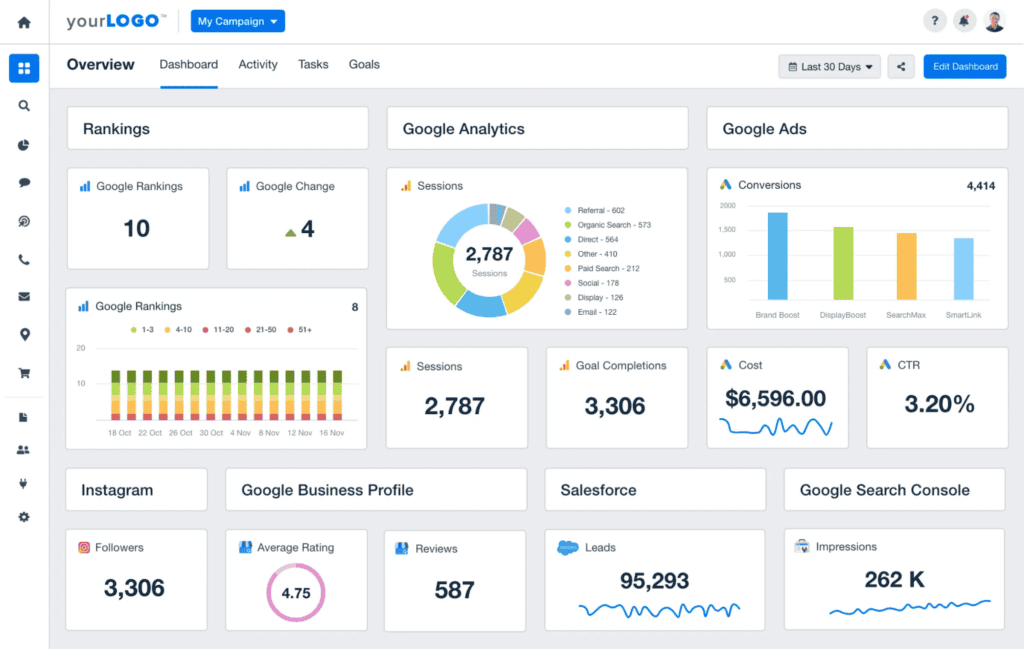
How To Use Google Ads Analytics to Refine Campaigns
To extract the most value from the metrics defined in the previous section, Google Ads Analytics should be an integral part of your campaign management:
- Identify patterns: Look for trends in times of day or locations that result in a higher CTR or conversion rate. Then, allocate more of your budget to these high-performing segments.
- A/B testing: Continuously test different elements of your ads, such as headlines, descriptions, and call-to-actions (CTAs), to see which versions perform the best. This is key to refining your messaging and improving engagement.
- Keyword optimization: Review the performance of your keywords and pause those that are underperforming or refine them to match the intent of your target audience more closely.
- Landing page performance: Analyze whether your landing pages effectively convert visitors from your ads into customers. If not, it’s time to optimize page content, load speed, or CTA placement.
- Use conversion tracking: Set up conversion tracking to understand how well your ads lead to valuable customer activity. This is critical for calculating CPA and ROAS.
- Adjust bids and budgets: Utilize the metrics to make informed decisions about bid strategies and budget adjustments. For instance, increase bids on high-performing keywords to maximize impression share.
- Monitor quality score: A low Quality Score can increase CPC and decrease ad visibility. Address the components of the Quality Score by improving ad relevance, landing page quality, and CTR.
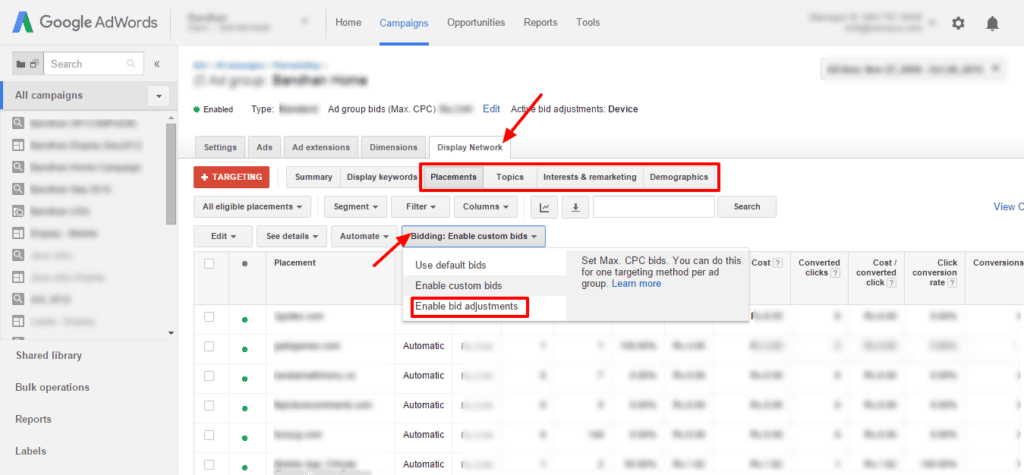
Summing Up
Your Google Ads journey can initially seem daunting, but it’s worth it for your digital marketing efforts. By understanding the different types of campaigns and knowing how to target and measure them, you’re setting a strong foundation.
Remember, Google ads are more than about being seen; they are about making meaningful conversions. So, draft with intention, use data as your compass, and let creativity guide your message to your future customers.
Let your ads tell your story, and watch as the clicks of today become the conversions of tomorrow.
Frequently Asked Questions
What makes Google Ads a valuable tool for small businesses?
Google Ads offers small businesses the advantage of reaching potential customers precisely when they are searching for related products or services. Its cost-effectiveness, measurable ROI, and the ability to target with precision make it a valuable tool for small businesses looking to grow their online presence.
How do I determine the right budget for my Google Ads campaign?
To set the right budget for Google Ads, calculate the cost-per-click (CPC) for your targeted keywords and estimate the number of clicks needed to convert to a sale. Start with a test budget based on these figures, then refine your budget as you gather performance data.
Remember to factor in the lifetime value of a customer to justify the cost of acquisition.
Can I Run Google Ads campaigns without professional help?
Yes, you can run Google Ads campaigns on your own. Google offers various tools and tutorials for beginners. However, for the best results, especially for more complex campaigns, professional expertise may be beneficial.
What are the most common mistakes small businesses make with Google Ads?
Besides lacking a clear strategy, small businesses might not optimize for mobile users, may overlook the use of ad extensions, or fail to update and test ad copy regularly. Additionally, neglecting to use conversion tracking or analytics can lead to missed opportunities for campaign improvement.
How long does it take to see results from Google Ads?
While immediate traffic is possible, building a successful Google Ads campaign is an ongoing process. Expect to spend several weeks fine-tuning to see consistent performance improvements as data accumulates and optimize keywords, ad copy, and bidding strategies for quicker and more effective results.
How often should I review and adjust my Google Ads campaigns?
Regular weekly reviews of campaign performance can highlight necessary adjustments to keywords, bids, and ad copy. Monthly deep dives into analytics are also recommended to understand broader trends and make data-driven strategic decisions.
What’s the difference between Search Ads and Display Ads?
Search Ads appear on search engine results pages when specific keywords are searched, targeting user intent, while Display Ads are visual ads that appear on various websites across the internet, aimed at building brand awareness.
How can I improve the quality score of my Google Ads?
To improve your Quality Score, focus on the relevance of your keywords to your ad groups, ensure your ad copy is compelling, optimize your landing pages for relevance and loading speed, and improve your ad’s CTR through testing and refinement.
Is it possible to target specific geographic locations with Google Ads?
Yes, Google Ads allows you to target specific geographic locations, ranging from entire countries to cities, or even a radius around a location. This targeting helps to focus your advertising on areas where you’ll find the right customers.
How do I ensure my Google Ads stand out against competitors?
Make your Google Ads stand out by crafting compelling ad copy, utilizing extensions to provide additional information, implementing A/B testing for continuous improvement, and maintaining a strong Quality Score for better positioning.
